In
my wanderings around Leith, I often end up in the rather picturesque kirkyard
of South Leith Parish Church. The area
around the church is a little blast of greenery and trees, the grounds being
hemmed in by a shopping centre, blocks of flats and the new tramline running
down from Edinburgh. It is a little
oasis to lots of birds, small creatures, and insects, who utilise everything
from the plants and trees to the gravestones.
Of course, though I enjoy it, I don’t really go there for the nature,
like any good graveyard ghoul, I go there for the gravestones and the stories
they tell.
The
graveyard used to be much larger, but part of it is now under Constitution
Street, the road that runs past it and on which the trams run. When they were constructing the tram lines,
they had to dig up the road, and while it was an open pit, a group of
archaeologists worked there to remove all the bones of those buried there. You could quite often walk past and see
several rather well preserved skeletons lying there as the work was carried
out. They were quite a talking point and
on social media there were many comments about how many of these skeletons
seemed to have a full set of lovely white teeth. Something many of those living nearby do not
have. It was soon pointed out though
that the skeletons dated from around the 16th Century, a time when
sugar was not in such abundance and that anyway most of the skeletons were from
people who were probably in their early to mid-twenties when they died. The skeletons were also quite popular with
local children, and I remember passing by a young woman with a screaming
toddler who calmed down when she told him that if he behaved, they would walk
home past the skeletons, and she’d lift him up so he could see them.
Being
an old maritime town many of those buried in the graveyard worked on the ships,
were ship builders, sailors or merchants utilising the shipping for their
businesses. One of the gravestones there
carries on it a memorial to one of the sons of James Kinghorn and Agnes
Anderson. This being William Anderson
Kinghorn, the Chief Engineer on the SS Esparto, who was drowned in the English
Channel on 28 November 1897.
The
SS Esparto was a cargo steamship built by S H Morton and Co at Victoria Dock in
Leith for the London and Edinburgh Shipping Company. It was launched on the 20 September
1880. On Thursday 25 November 1897 it
set off from Bo’ness to sail to Barcelona with a cargo of coal. On the night of Sunday 28 November, the ship
was passing through the English Channel, by the Royal Sovereign Lightship near
to Hastings, when it was involved in a collision with the French steamship, the
Noel. It would appear that in heavy seas
the two ships came across each other and through errors in signalling they
embarked on a course that led them directly into each other’s path. The Esparto was hit midship by the Noel and
was almost cut in two. Water flooded
into the ship, but most of those below decks managed to scramble up and some
made it onto the deck of the Noel.
However, just as the First Mate shouted over to the crew of the Noel to
try and hold their ship so the rest of his crew could get aboard, the rough
seas pulled it out and away from the Esparto.
The Esparto then capsized and within five minutes had sunk. Two of the Esparto’s crew who had made it on
to the Noel, took out one of the lifeboats from that ship and rescued several
of their crew members who had been thrown into the sea. Meanwhile the Captain, William Kinghorn and
another member of the crew managed to get into a lifeboat from the Esparto and
for a short while thought they were all saved.
But then the rough seas overturned the boat, and all three were cast
into the churning waters. The Captain
managed to grab onto some wreckage from the Esparto and was saved by a passing
ship. Unfortunately, Kinghorn and the
other crew member were not so lucky, and both drowned in the freezing and
stormy sea. Of the nineteen people onboard
the ship, fourteen were rescued but five drowned. Their bodies were never
recovered.
An
enquiry was held into the sinking of the ship, and it concluded that the
accident had been caused due to errors made by the mate of the Esparto in
signalling and pulling astern from the Noel when this was not necessary and by
the fact that ‘neither of the vessels kept on her course’.
There
are also some tragic tales to be had amongst the surviving gravestones. There is the grieving wail from the past that
is the inscription for James Paton, a merchant in London who died in Leith in
1787. On his headstone is carved a
lament from his grieving widow to a man who was a loving father to his young
children and who had brought much happiness to her.
One
of the gravestones that intrigued me was that of Martha Watt, who died on 2 May
1901 and whose inscription states that she was accidentally drowned. I found the word ‘accidentally’ somewhat
strange as it almost implied that it may not have been an accident. Why the emphasis? Well, it turns out that poor Martha threw
herself into Dunsapie Loch in Holyrood Park and drowned herself despite a passer-by
trying to save her. However, the
Procurator Fiscal’s Office ruled her death accidental, which suggests that they
found that she was ‘not of sound mind’ when she did this. Given the stigma surrounding suicide at that
time the ‘accidentally’ on her gravestone serves to hit this home to all the
gossips that it was not a deliberate act by her.
Many
of those buried here lie in unmarked graves and their tales and stories and now
lost to us. However, somewhere within
the grounds of the graveyard lie the bodies of three men and their story is
well documented. Their tale is one of
revenge, bigotry, hate and ultimately of judicial murder and it all started
with a Scottish company.
In
1695 The Company of Scotland was created and granted a monopoly of Scottish
trade to India, Africa, and the Americas.
The company played a large role in the ill-fated Darien scheme, in which
an attempt was made to establish a colony in Panama. This all went wrong and failed due to poor
planning, the death of most of the colonists from tropical diseases, a trade blockade
carried out by England and an aggressive military response by the Spanish. The failure
of this scheme and the fact that it had almost bankrupted Scotland, led to huge
resentment and anger with England, who many believed had been responsible for
causing the failure. Something the Secretary
of the Company of Scotland, Roderick MacKenzie, was only too happy to have
people believe, as it took any responsibility for the failure away from him and
his colleagues.
In
1704, the Annandale, a ship chartered by The Company of Scotland was impounded in
the Thames by the English authorities. The captain of the ship was accused of trying
to hire English sailors in London, which was a breach of the East India
Company’s monopoly. The ship was
eventually seized along with all the goods on board and the ship’s crew were pressed
into the service of the English Navy.
This didn’t go down well back in Scotland and really annoyed many of the
merchants and politicians, as it was basically the final nail in the coffin of The
Company of Scotland. Around six months
later an English merchant ship, the Worcester, was returning from the East
Indies loaded up with a full cargo. In
order to avoid a storm, it put in at the Firth of Forth. There, it was seized in an act of reprisal by
the Scottish authorities at the behest of Roderick MacKenzie.
At
around the same time the Worcester was seized, concern was growing in Edinburgh
over another Scottish ship, the Speedy Return, which, not living up to its
name, had not returned to port and was assumed to be lost. Rumours soon spread that the captain and crew
of the Worcester were responsible for the loss of the Speedy Return. Given
these rumours Captain Thomas Green of the Worcester, and his crew, were all detained
and imprisoned.
The
ship’s cook, Antonio Ferdinando, who is described as coming from Malabar in
India, though may have actually been an enslaved African, then made a statement
against Captain Green and the crew, stating that off the coast of Calicut in
India, they had attacked a ship of English speaking men and had killed them,
stolen the goods from the ship, and then sold the ship. However, it would appear that Ferdinando had
not actually joined the ship until after it had sailed past Calicut, so he could
not have witnessed any of this. His
statement against the crew may therefore have been due to an understandable
grudge against them.
However,
that aside, in March 1705 Captain Green and his crew went on trial at an Admiralty
Court in Edinburgh on charges of piracy, robbery and murder. The indictment against them was kept vague
and did not specify which ship it was that they were supposed to have attacked or
the date they were supposed to have attacked it. None of the owners of the Speedy return or
family members of the crew were asked to give evidence. The crew of the Worcester were not allowed to
give evidence in their defence, though Ferdinando was allowed to give evidence
against them, and vital evidence that would have shown that they did not carry out
an attack on the Speedy Return was not considered by the court. This evidence being that two members of the
crew of the Speedy Return had made it back to England where they had signed statements
to the fact that their ship had been seized off the Madagascar Coast by a gang
of pirates led by a Captain John Bowen. It
would appear the Captain of the Speedy Return had been negotiating the purchase
of a group of slaves from Bowen but had been double crossed by him. Realising he had been duped and lost his ship,
the Captain had gone to seek his fortune elsewhere rather than returning to
Scotland to face the wrath of the ship owners.
He had left his crew stranded in a foreign land from which they had to
find their own way home. And why was
this evidence not considered? Well, it
was because the indictment against them didn’t actually mention the Speedy
Return, as its vagueness was really just a ploy to ensure a guilty verdict,
such was the anti-English sentiment at the time. As the historian George M Trevelyan put it,
the court was ‘drunk with patriotic prejudice.’
So,
as expected, Captain Green and sixteen members of his crew were found guilty
and sentenced to death. Captain Green,
his Chief Mate, John Madder, and the ship’s gunner, James Simpson, were all
sentenced to hang on the 4th of April 1705, while the rest of the
crew were to be executed in two groups on the 11th and 18th
of April.
There
was much consternation in England about the trial and the sentence imposed upon
Green and his crew. Queen Ann intervened
and asked for a stay of execution so the matter could be considered properly by
her ministers. This was granted until
the 11th of April, but then on the 11th a huge and angry
crowd gathered in Edinburgh demanding that justice be carried out for the
murdered crew of the Speedy Return. The
Lord Chancellor was spotted by the mob and dragged out of his coach, only
escaping the angry crowd by promising that the executions would go ahead. So later that day Green, Madder and Simpson
were put in a cart and transported through a baying mob to Leith Sands. There, all three made final speeches
declaring their innocence, before being hanged.
Unusually though, rather than being left to hang in chains like the
bodies of most convicted pirates, all three were quickly cut down and taken to
South Leith Parish Church and buried in the graveyard there. Not long after this the rest of the crew were
discreetly released, the anger of the mob having been abated by a blood sacrifice.
Only
a few years later, in 1707, the Act of Union and the joining of England and
Scotland resulted in closure of The Company of Scotland and compensation being given
to the merchants and nobles who had lost so much of their cash. The deaths of Green and his two other crew
members were quickly forgotten, as was the Speedy Return.
***
Wandering
around the graveyard I bumped into several groups of tourists taking in the
sites of Leith. As they admired the many
ornate and ancient gravestones I walked around to the crypts. There amongst the capering squirrels and fat
pigeons I came across a small group of men that you often find in inner city
graveyards, scruffy looking and very drunk.
Empty cans of cheap cider were scattered around them as they shouted and
laughed noisily at each other. Walking
past them through the crypts I found another group sitting quietly in the grass
looking completely out of it. Around
them lay the detritus of their addiction, bloody tissues, swabs and syringes. One of the guys looked up at me vacantly and
managed a smile. I smiled back, said
hello, and headed away out into the warmth of the summer sun.
As
I walked through the graveyard, I found a bit of wall that at one time must
have been part of something but now was just a lone piece of wall with some
gravestones attached to it. There, in a
gap, I left the Skulferatu that had accompanied me.
The
coordinates for the location of the Skulferatu are –
I
used the following sources for information on those buried within the graveyard
at South Leith Parish Church –


























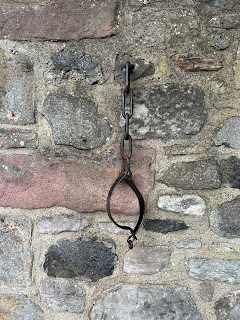

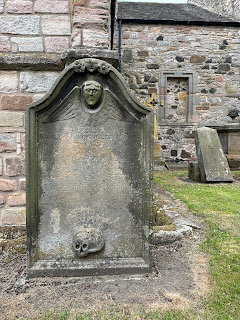

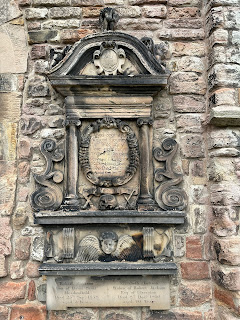




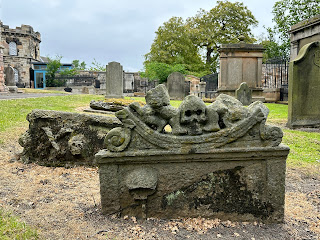


.jpg)
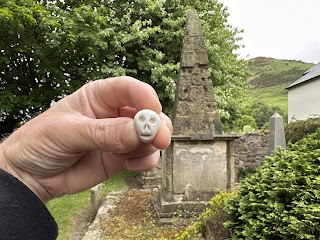
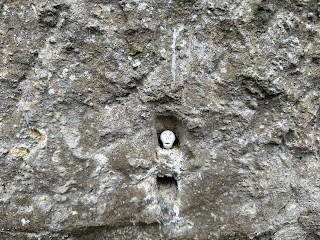


.JPG)
.JPG)
.JPG)
.jpg)
.jpg)
.JPG)
.jpg)
.JPG)
.JPG)
.jpg)
.jpg)
.JPG)
.jpg)
.JPG)
.JPG)
.JPG)
.JPG)
.jpg)
.jpg)
.jpg)
.JPG)
.JPG)
.jpg)
.JPG)
.JPG)
.jpg)
.jpg)

